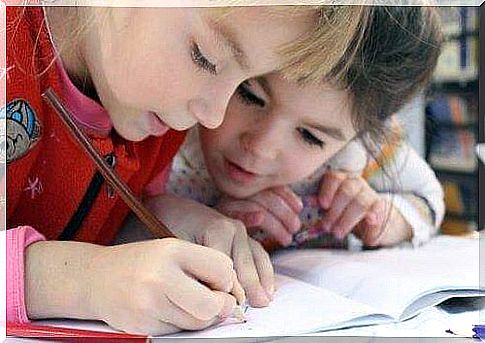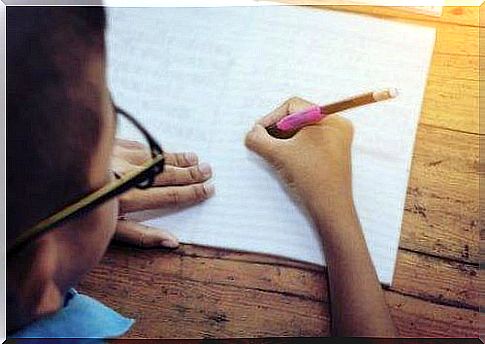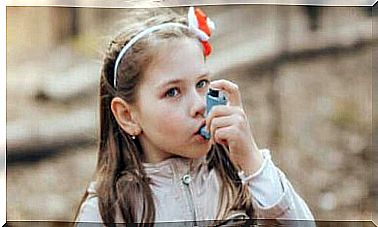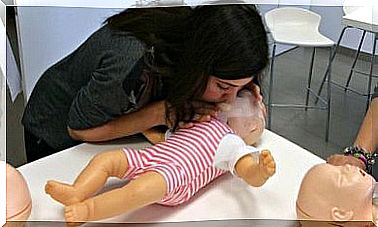5 Exercises To Improve Children’s Handwriting

When you improve children’s handwriting, you also improve their fine motor skills and their hand-eye coordination. Although it seems like a fairly simple task to use a pencil, writing involves a simultaneous development of motor and sensory processes that are not always automatic. The writing process is also clearly dependent on sufficient muscular development in the hands.
“Psychomotor development is based on two principles: from the global to the selective and from the proximal to the distal, indicating that the development of musculature and motor ability originates from the torso, to the shoulders and on to the hands and fingers.”
–Tracey Le Roux–
It is clear that you can not ensure good handwriting if your child has not yet developed the right motor skills as described above. In addition, the child must develop the ability to use three-finger grips to maintain the pencil appropriately.
Another key component to improving children’s handwriting is that they learn to make fluent strokes.
As a general measure, it is expected that most children around 6 years of age have gone from using the five-finger grip in preschool to using the three-finger grip. With the three-finger grip, the written exercises described below will be more effective.
Main elements to improve children’s handwriting
1. Hold the pencil correctly
To begin with, it is necessary for children to hold the pencil with their thumb, forefinger and middle finger.
Another important aspect is that the length and thickness of the pencil should be appropriate to the size of the child’s hand. At the same time, the child’s grip on the pencil should be firm, but not too tight.
2. Maintain proportions
One of the reasons why a child’s handwriting may seem sloppy or difficult to understand is due to lack of implementation.
It is important to use a special notebook printed with double lines. This will help the child to distinguish between the height of uppercase and lowercase letters.

Use entertainment to motivate practice
Some activities that can help improve handwriting in children are traditional games. Connect the dots, alphabet soup and gallows are fun ways to learn how to better handle a pencil.
4. Strengthen muscle groups
As mentioned above, children’s fine motor skills depend on muscle development. For this reason, it is important to train fingers and wrists every day.
Some easy ways to do this are: play with sand, play with building blocks, use cutlery at the table, paint, cut-paste or modeling wax.
5. Spend more time reading
It is true that reading not only enhances creative and cognitive development, but also a child’s writing. The more familiar the child is with the defined lines and proportions for each letter, the easier it becomes.
If the child is used to reading, he or she will have a more concrete mental picture of what it is like to write letters.
In other words, children who read a lot learn to imitate letters more easily.
Other important tips for improving children’s handwriting
- Consider and acknowledge the extent of a deeper problem. Many children with handwriting problems have other learning difficulties. Messy handwriting can hide spelling problems and inattention. Unclear handwriting can also show a lack of interest in certain academic topics.
- Give them a friendly and positive environment. This is so that children do not feel that practicing the handwriting exercises is a punishment. Choose a place where they can sit properly with good posture and where the lighting is adequate so that they can practice and hone this skill more effectively.

- Avoid putting too much pressure on your child. Patience and calmness help your child feel more secure and competent. That is, rushing or forcing your child to write quickly and well can be counterproductive and cause unnecessary frustration.
- Use exercise books and templates. There are a large number of exercise books that offer examples of writing that can be followed with the pencil. There are also many types of templates available to help children draw individual letters more evenly and to practice their handwriting. In addition, many of the available products also stimulate other fine motor skills such as coloring, cutting and drawing.
- Stimulate their artistic abilities. Painting or making sculptures not only stimulates creativity, it also helps increase coordination. Above all, coordination is a basic condition for children to correctly write each letter of the alphabet.
Improving children’s handwriting is not an impossible task if they practice regularly. Applying the right tactics will ensure that handwriting does not become a tedious task for your child, but rather a moment in parts.
Make practice handwriting entertaining, and strengthen this important ability with amazing results.









